 W
WAmeiva ameiva, also known as the giant ameiva, green ameiva, South American ground lizard, or Amazon racerunner, is a species of lizard in the family Teiidae found in Central and South America and some Caribbean Islands.
 W
WAmphisbaena mertensii, also known as the Mertens' worm lizard or Mertens's worm lizard, is a species of worm lizard in the family Amphisbaenidae. The species is endemic to South America.
 W
WApostolepis assimilis is a species of snake in the family Colubridae. It is found in central and southwestern Brazil, eastern Paraguay, Bolivia, and northern Argentina; the Reptile Database, however, does not mention Bolivia and treats Argentina as uncertain.
 W
WThe Argentine black and white tegu, also called commonly the Argentine giant tegu, the black and white tegu, the huge tegu, and in Spanish as the lagarto overo is a species of lizard in the family Teiidae. The species is the largest of the "tegu lizards". It is an omnivorous species which inhabits the tropical rain forests, savannas, and semi-deserts of eastern and central South America.
 W
WThe Argentine snake-necked turtle, also known commonly as the South American snake-necked turtle is a species of turtle in the family Chelidae. The species is known for the long neck to which its common names refer. Despite appearances, the Argentine snake-necked turtle is probably more closely related to the mata mata than to the Australian snake-necked turtles in the genus Chelodina. H. tectifera is found in northern Argentina, Uruguay, Paraguay, and southern Brazil. Not much is known about it, as it has not been extensively researched. It is a popular pet in the exotic pet trade.
 W
WThe Argentinian coral snake is a species of coral snake in the family Elapidae.
 W
WAurivela longicauda, the longtail whiptail, is a species of teiid lizard endemic to Argentina.
 W
WThe black spine-neck swamp turtle, also commonly known as the spiny-neck turtle or Spix's sideneck turtle, is a species of turtle in the family Chelidae. The species is endemic to Central America and northern South America.
 W
WBoa constrictor occidentalis, also commonly known as the Argentine boa, is a subspecies of large, heavy-bodied, nonvenomous, constricting snake. Boa constrictor occidentalis is a member of the family Boidae, found in the subtropical temperate west of Argentina and Paraguay, although some members have been reported to exist in Bolivia as well.
 W
WBorelli's marked gecko is a species of gecko. It lives in Argentina and Paraguay.
 W
WBothrops alternatus is a venomous pit viper species found in South America. Within its range, it is an important cause of snakebite. The specific name, alternatus, which is Latin for "alternating", is apparently a reference to the staggered markings along the body. No subspecies are currently recognized.
 W
WBothrops ammodytoides is a venomous pit viper species endemic to Argentina. No subspecies are currently recognized.
 W
WBothrops jararaca — known as the jararaca or yarara — is a species of a highly venomous pit viper endemic to South America in southern Brazil, Paraguay, and northern Argentina. The specific name, jararaca, is derived from the Tupi words yarará and ca, which mean "large snake". Within its geographic range, it is often abundant and is an important cause of snakebite. No subspecies are currently recognized.
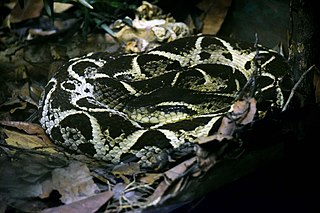 W
WBothrops jararacussu, commonly known in English as the jararacussu, is a highly venomous pit viper species endemic to South America. It's one of the most dreaded snakes in South America and can grow up to 2,20 meters.
 W
WThe broad-snouted caiman is a crocodilian reptile found in eastern and central South America, including southeastern Brazil, northern Argentina, Uruguay, Paraguay, and Bolivia. It is found mostly in freshwater marshes, swamps, and mangroves, usually in still or very slow-moving waters. It will often use man-made cow ponds.
 W
WThe yacare caiman, also known commonly as the jacare caiman, Spanish 'yacaré', Paraguayan caiman, piranha caiman, red caiman, southern spectacled caiman,, jacaré in Portuguese and îakaré in Old Tupi, is a species of caiman, a crocodilian in the family Alligatoridae. The species is endemic to Argentina, Bolivia, Brazil, and Paraguay. Brown in color and covered with dark blotches, males grow to a total length of 2–3 metres (6.6–9.8 ft) and females to 1.4 metres (4.6 ft). Typical habitats of this caiman include lakes, rivers, and wetlands. Its diet primarily consists of aquatic animals, such as snails, and occasionally land vertebrates. Mating occurs in the rainy season and eggs hatch in March, with young fending for themselves as soon as they hatch. The yacare caiman was hunted heavily for its skin to use for leather in the 1980s, which caused its population to decrease significantly. However, trading restrictions placed since have caused its population to increase. Its population in the Pantanal is about 10 million, and it is listed as least concern on the IUCN Red List.
 W
WThe Chaco tortoise, also known commonly as the Argentine tortoise, the Patagonian tortoise, or the southern wood tortoise, is a species of tortoise in the family Testudinidae. The species is endemic to South America.
 W
WNotomabuya is a genus of skinks. It contains one species, Notomabuya frenata, which is found in South America (Brazil, Bolivia, Paraguay, and northeast Argentina.
 W
WCrotalus durissus is a highly venomous pit viper species found in South America. The most widely distributed member of its genus, this species poses a serious medical problem in many parts of its range. Currently, seven subspecies are recognized, including the nominate subspecies described here.
 W
WD'Orbigny's slider or the black-bellied slider, commonly known in Brazil as tartaruga-tigre or tartaruga-tigre-d'água, is a species of water turtle in the family Emydidae. The species is found in southern Brazil, northeastern Argentina, and Uruguay. Two subspecies are recognized as being valid, Trachemys dorbigni adiutrix and Trachemys dorbigni brasiliensis.
 W
WDiplolaemus darwinii, commonly known as Darwin's iguana, is a species of lizards native to the southern tip of South America.
 W
WDiplolaemus leopardinus, commonly known as the leopard iguana or the leopard grumbler, is a species of lizard native to the southern tip of South America.
 W
WErythrolamprus aesculapii, commonly known as the false coral, boicora, or falsa coral, is a colubrid snake endemic to South America.
 W
WHomonota fasciata, also known as the South American marked gecko, is a nocturnal species of gecko. It lives in Bolivia, and in Argentina. It is found in tropical deciduous forest and desert scrub habitats. It feeds on insects.
 W
WHomonota horrida, also known as South American marked gecko, is a species of gecko. It lives in Argentina and Paraguay.
 W
WHydrodynastes gigas is a New World species of large, rear-fanged, colubrid snake endemic to South America. It is commonly and alternatively known as the false water cobra and the Brazilian smooth snake. The false water cobra is so named because when the snake is threatened it "hoods" as a true cobra does. However, unlike a true cobra, it does not rear up, but remains in a horizontal position. There are no subspecies which are currently recognized as being valid.
 W
WImantodes cenchoa is a species of rear-fanged colubrid snake distributed in Mexico, Central America, and South America.
 W
WLiolaemus chiliensis is a species of lizard in the family Iguanidae. It is endemic to Chile and southwestern Neuquen Province, Argentina.
 W
WLiolaemus darwinii is a species of iguanid lizard endemic to Argentina.
 W
WLiolaemus fuscus is a species of lizard in the family Iguanidae. It is found in parts of western Argentina and central Chile in the Chilean matorral ecoregion. The conservation status of this iguana is classified as Data Deficient (DD).
 W
WLiolaemus lemniscatus is a species of lizard in the family Iguanidae. It is found in Argentina and Chile.
 W
WLiolaemus pictus, the orange-bellied lizard, is a species of lizard in the family Iguanidae. It is endemic to Chile and Argentina.
 W
WLiolaemus umbrifer is a species of lizard in the family Liolaemidae. It is endemic to the Catamarca Province in northwestern Argentina.
 W
WMicrurus altirostris is a species of coral snake in the family Elapidae.
 W
WMicrurus baliocoryphus is a species of coral snake in the family Elapidae. It is found in South America.
 W
WMicrurus corallinus is a species of highly venomous elapid snake native to South America. There are no recognized subspecies.
 W
WMicrurus frontalis is a species of a highly venomous coral snake in the family Elapidae. It is found in South America.
 W
WMicrurus lemniscatus, commonly known as the South American coral snake, is a species of venomous snake in the family Elapidae. The species is endemic to South America.
 W
WThe military ground snake is a species of snake in the family Colubridae. The species is endemic to South America. In 1964 Gans gave it the common name common water snake.
 W
WOxyrhopus guibei is a species of snake in the family Colubridae. The species is endemic to South America. It is often called the false coral snake, but this common name can refer to any of a long list of other species, genera, and even entire families of snakes. Many nonvenomous snakes have evolved coloration that mimics that of venomous true coral snakes, a trait which helps them avoid predation.
 W
WPalusophis bifossatus is a species of snake of the family Colubridae.
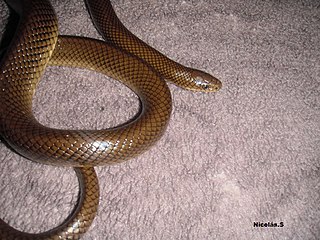 W
WParaphimophis is a genus of snake in the family Colubridae that contains the sole species Paraphimophis rusticus. It is commonly known as the Culebra.
 W
WPhilodryas aestiva is a species of snake of the family Colubridae. It is commonly known as the Brazilian green racer and the common green racer.
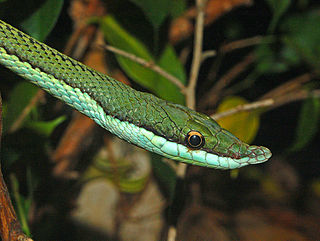 W
WPhilodryas baroni, common name Baron's green racer, is a species of mildly venomous snake in the family Colubridae. The species is endemic to South America.
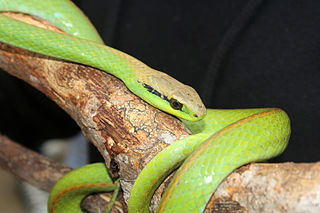 W
WPhilodryas olfersii is a species of venomous snake in the family Colubridae. The species is endemic to South America.
 W
WPhilodryas trilineata is a species of snake of the family Colubridae.
 W
WPhrynops williamsi, commonly known as William's toadhead turtle or William's South American side-necked turtle, is a species of turtle endemic to South America.
 W
WPolychrus acutirostris, the Brazilian bush anole, is a species of lizard native to southern and eastern Brazil, Paraguay, Argentina, and eastern Bolivia. It is diurnal.
 W
WThe red tegu is a lizard native to western Argentina, Bolivia and Paraguay. It is sold in the pet trade around the world because of its relatively docile nature and because it is comparatively easy to keep.
 W
WTaeniophallus occipitalis is a species of snake in the family Colubridae. It is widely distribution in South America and occurs from northeastern Peru and Colombia south and east to large parts of Brazil, Bolivia, Paraguay, Uruguay, and northern Argentina. It is oviparous.
 W
WThamnodynastes hypoconia is a species of snake in the family Colubridae. The species is endemic to South America.
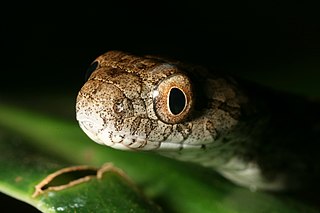 W
WThamnodynastes pallidus is a species of snake in the family Colubridae. The species is endemic to South America.
 W
WTropidurus torquatus is a species of lizard in the family Tropiduridae, the Neotropical ground lizards. Its common name is Amazon lava lizard.
 W
WThe big-headed pantanal swamp turtle or pantanal swamp turtle is a species of turtle in the family Chelidae found in Argentina, Bolivia, Brazil, and Paraguay.
 W
WVanderhaege's toad-headed turtle is a species of turtle in the family Chelidae. The species is endemic to South America.
 W
WXenodon merremii, also known commonly as Wagler's snake, is a species of snake in the subfamily Dipsadinae of the family Colubridae. The species is endemic to South America and is widespread in the eastern half of the continent.
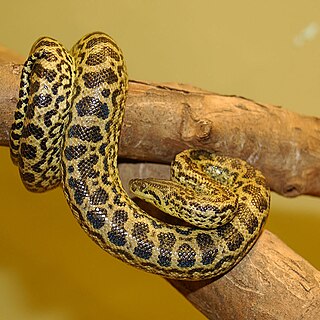 W
WThe yellow anaconda, also known as the Paraguayan anaconda is a boa species endemic to southern South America. It is one of the largest snakes in the world but smaller than its close relative, the green anaconda. Like all boas and pythons, it is non-venomous and kills its prey by constriction. No subspecies are currently recognized.